Abstract
Urban planning in China is shifting from an administrative unit-based approach to community life circle planning, aiming to align planning units with residents’ actual activity ranges. As the most fundamental life circle, daily life circle (DLC) planning must adopt a bottom-up approach. However, the widely applicable methods for delineating DLCs remain lacking. This study presents a strategy for delineating DLCs centered on neighborhood commercial areas that aggregate essential daily life services. Correspondingly, a method is proposed for identifying neighborhood commercial areas based on residents’ actual usage of facilities. The method was applied in Qinhuai District, Nanjing, where neighborhood commercial areas were identified and the factors influencing their formation and types were quantitatively analyzed. The results indicate the following: (1) the proposed method accurately identifies neighborhood commercial areas that can serve as DLC central areas; (2) commercial diversity, public transportation stops, and parking spots are the three most influential factors in neighborhood commercial area formation, exhibiting non-linear and threshold effects; and (3) the type of neighborhood commercial areas varies by population density, housing prices, and street betweenness, with betweenness being the most significant factor. These findings provide methods and indicators for DLC delineation and planning, contributing to the realization of the DLC construction concept.
1. Introduction
Faced with rapid urban expansion, climate change, and aging populations, many countries worldwide strive to develop livable and sustainable urban environments. Among various strategies, including transit-oriented development (TOD), resilient cities, and eco-cities, the “15-min city/life circle” concept has emerged as one of the most popular approaches to achieving these goals at the current stage, attracting global attention. This concept aims to enhance urban sustainability by clustering essential services within walking distance, thereby significantly reducing transportation demand and carbon emissions, ultimately improving community livability and service efficiency [1,2,3]. To date, this concept has been adopted and implemented in cities across several countries [4,5,6]. In 2018, China shifted from a traditional administrative district-based model to a community life circle planning model, which has since become a key tool for improving the urban environment and enhancing residents’ quality of life [7,8].
The objective of community life circle planning is to achieve effective coordination between residents’ walking ranges and the network of daily life service facilities. Current research primarily focuses on administrative districts, evaluating the supply–demand balance of services within a defined walking radius centered on residential communities or buildings [9,10,11,12]. While these evaluations provide insights into optimizing service layouts at localized scales, they offer limited guidance for broader citywide community life circle planning. Moreover, although some studies have revealed service deficiencies in specific regions, these regions may not be conducive to the establishment and operation of service facilities. Therefore, it is essential to shift perspectives by rationally delineating community life circles before allocating the required services. This contributes to bridging the inequalities in service access among different socioeconomic groups [13].
The daily life circle (DLC) serves as the foundation of life circles, encompassing essential space for residents’ daily activities, such as work, shopping, and schooling [3]. Additional activities, including social and voluntary activities (particularly community mutual-aid activities), should also be developed collaboratively within the DLC [14]. This approach offers residents a comprehensive living experience in their daily lives. The DLC develops naturally over time. First, natural factors such as mountains and rivers, along with infrastructure like roads, bridges, and public transportation, influence residential areas and the activity patterns of residents [15,16,17]. Second, industrial development promotes population concentration, which in turn drives the growth of community commerce [18,19]. Third, cultural traditions and associated festivals periodically attract people to specific locations [20]. These complex factors collectively shape region-specific DLC over time. Within DLC, various commercial establishments such as supermarkets, wet markets, grocery stores, convenience stores, and repair shops tend to cluster, forming the neighborhood commercial area (NCA) [21]. The agglomeration not only enhances convenience for residents but also significantly boosts the efficiency and profitability of commercial activities [22,23,24]. In summary, DLC planning must adopt a bottom-up approach, examining the actual range of residents’ daily activities. However, the absence of widely applicable methods represents a gap in the research.
To fill the gap, a practical approach to DLC planning is to first identify NCAs and designate them as the central areas of DLCs and then allocate surrounding residential areas to the same DLC. This approach aligns with emerging perspectives in regional geography, conceptualizing life circles as formations driven by residents’ actual activities and network connections rather than aligning with administrative boundaries. It emphasizes the distinctiveness between different life circles [25]. This study focuses on the following: (1) identifying NCAs, (2) exploring the factors influencing the formation of NCAs, and (3) classifying NCAs and analyzing their spatial characteristics. These findings lay the foundation for a bottom-up perspective to delineate the DLC and plan the central area, thus promoting the implementation of the DLC planning concept.
Using commercial facility location data for density analysis enables a cost-effective and rapid preliminary identification of commercial areas. Notably, the kernel density estimation method can reveal the continuous spatial density variation in facilities, enabling the identification of commercial clusters relative to the surrounding context rather than relying on POI density peaks (Table 1). However, in old cities in China, NCAs are usually distributed continuously. In contrast, the central area of the DLC should maintain appropriate spacing to ensure equitable service. More importantly, the NCAs that serve as DLC center areas should ideally be identified based on residents’ actual usage of facilities. Thus, it is necessary to incorporate data on residents’ distribution during times outside of work and home sleeping hours to further refine NCA identification. Compared to previously used self-reported activity data [26,27] and mobile signaling data [28], the recently developed Baidu Heat Map (BHM) offers advantages such as low cost and easy access. Recent studies have demonstrated that these data can effectively capture and analyze the spatiotemporal distribution of residents [29,30], providing an opportunity to efficiently and accurately identify NCAs.

Table 1.
Identification of commercial areas based on facility location data.
The rational distribution of NCAs is crucial for achieving the objective of DLC planning. However, reliable indicators to guide NCA planning are still lacking. Previous studies have pointed out that factors such as population density, land use, road network, street centrality, and transportation facility influence the distribution of commercial facilities [36,37,38,39,40] and the vitality of commercial areas [41,42,43,44,45]. Despite these insights, no empirical studies have been conducted to validate the effects of these variables on the formation of NCAs. Furthermore, many models employed in previous studies assume linear relationships among variables, neglecting potential non-linear and threshold effects (Table 2). However, recent studies have shown that these effects are applicable to the relationship between the built environment of shopping destinations and residents’ shopping trips [46].

Table 2.
Research on factors influencing the distribution of commercial facilities and vitality of commercial areas.
The structure of the remainder of this paper is organized as follows: Section 2 provides a detailed introduction of the study area, data, and methods employed in this study. Section 3 presents the research results. Section 4 provides a discussion of the research findings. Finally, Section 5 summarizes the main conclusions and acknowledges certain limitations.
2. Materials and Methods
This study explores the method for identifying NCAs and formation, types, and spatial characteristics of NCAs (Figure 1). The research on identification method involves two primary steps: proposing the method (Step 1) and evaluating the method by assessing the accuracy of the identification results (Step 2). Following the confirmation of the accuracy of the identification results, this study quantitatively analyzed the factors influencing the formation of NCAs (Step 3). Subsequently, NCAs were classified based on the spatial forms of commercial facilities within areas, allowing for a comparison of the spatial characteristics of areas where different types of NCAs are located (Step 4).
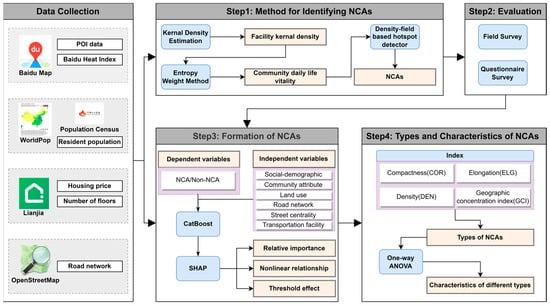
Figure 1.
Research framework.
2.1. Study Area
We selected Qinhuai District as the study area (Figure 2). Qinhuai District is located in Nanjing, the capital city of Jiangsu Province in southeastern China. Among Nanjing’s four main districts, Qinhuai District covers an area of 49.11 km2 and is administratively divided into 12 subdistricts. According to the Seventh National Census, the district recorded a resident population of 740,809, accounting for 7.95% of the city’s total population. In 2021, Nanjing was designated as the first national pilot city for developing 15-minute community life circles. The Nanjing Municipal Bureau of Planning and Natural Resources issued the Nanjing planning guidance of 15-minute community life circles in 2023 [5] to promote the development of community life circles.
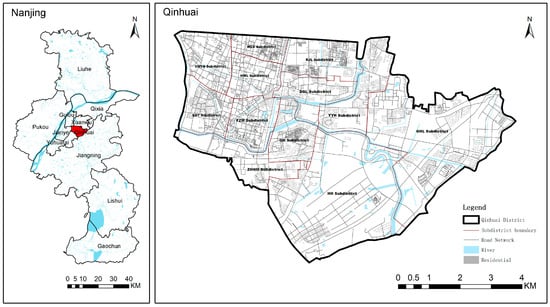
Figure 2.
Study area.
2.2. Data
In this study, five types of data were utilized: Baidu Heat Index (BHI), POI data, community attribute data, resident population data, and urban administration map data (Table 3).

Table 3.
Data sources used in this study.
BHI is derived from BHM. Baidu, the largest search engine in China, offers a variety of services similar to Google, including Baidu Search and Baidu Maps, which cover multiple aspects of residents’ daily life. In 2023, Baidu Search held 88.4% of the monthly active users in the search industry, ranking first [47]. BHI is generated based on the geographic locations of Baidu mobile application users, indicating the distribution of users across regions. Recent studies have confirmed that BHI is a reliable proxy for measuring the dynamic of human activities and regional vitality, proving valuable for urban research [48,49,50]. This study aims to extract data on resident distribution outside of working and home sleeping hours. To distinguish activity purposes, BHI data were collected on two weekdays (12 April and 12 July 2023, both Wednesdays). No extreme weather events during these periods were recorded that could have influenced residents’ daily activities. BHI were extracted for two specific periods: 8:00–9:00 and 18:00–21:00. Considering that typical weekday working hours span from 09:00 to 17:00, BHI values were notably lowest between 00:00 and 06:00, with a marked decline observed during the 22:00–23:00 interval, when compared to other evening hours on both days (Figure 3).
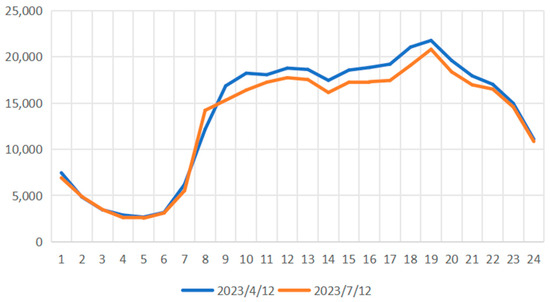
Figure 3.
BHI of study area on 12 April and 12 July 2023.
POI data for facilities were sourced from the Baidu Map API, collected in June 2023. Comparative analysis shows alignment between these data and the data from April and July 2023, attributable to the relative stability of urban service facilities over a period. POIs represent geographic entities as points, containing information such as latitude and longitude coordinates, names, and categories. This data type offers extensive coverage, substantial information, easy accessibility, and high accuracy. POI categories resemble land-use types, allowing the density of POI to reflect land-use patterns and functional zoning [51]. Furthermore, as service facilities provide essential spaces for activities [52], linking POI data with population activity data helps to identify activity types [53]. In this study, commercial facilities providing daily life services were selected based on the “Statistical Classification of Life—related Service Industries (2019)” published by National Bureau of Statistics of China [54]. The data processing steps include the following: (1) Excluding certain categories of services, such as daycare services, which are not required by all residents, long-distance travel services with low daily utilization, and digital cultural services lacking offline service. (2) Removing services located in the XJK city-level business district, where facilities primarily do not meet daily life needs. (3) Performing manual deduplication, correction, and completion of missing information to clean the filtered data.
Ultimately, a total of 16,366 commercial facility POIs in the study area were collected. The data were reclassified into six primary categories and thirteen subcategories based on relevant documents [54,55] (Table 4 and Figure 4). Additionally, POI data for transportation facilities were collected, including bus stops, subway stations, and parking spots, totaling 3446.

Table 4.
Categorization of commercial facilities providing daily life services.
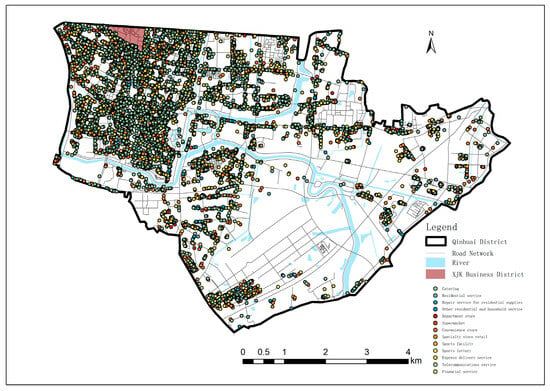
Figure 4.
Distribution of commercial facilities providing daily life services.
Community attribute data were sourced from the online real estate platform Lianjia. This study extracted data on construction year, housing price, and number of floors of residential complexes from the platform. The housing price represents the average values from April and July 2023. Resident population grid data were obtained from the WorldPop 2020 dataset, which features a resolution of 100 m. To ensure data accuracy, the WorldPop data were adjusted based on the Seventh Population Census of Nanjing [56]. Urban management map data were acquired from OpenStreetMap, encompassing administrative boundaries and road network data for Qinhuai District, Nanjing. To mitigate bias in the research results, unbuilt roads were excluded, with only the centerlines of built roads being extracted.
2.3. Identification Method
The method for identifying NCAs consists of two steps: measuring community daily life vitality and detecting vitality hotspots (Figure 5).
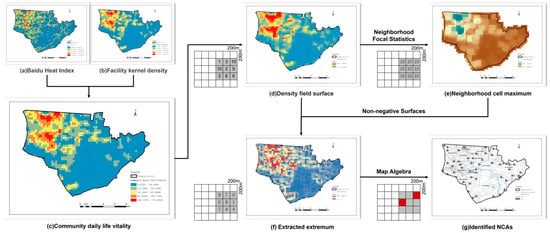
Figure 5.
Method for identifying NCAs.
2.3.1. Measuring Community Daily Life Vitality
Community daily life vitality is measured based on BHI and the density of commercial facilities. In this study, Thiessen polygons were created from BHI sampling points to serve as analysis units.
First, BHI of each analysis unit (Figure 5a) is calculated using the following formula:
where Bi represents the average BHI of analysis unit i, Ti is the total BHI of unit i during specific time periods, and Si is the area of unit i. n refers to the 12 time periods (7:00, 8:00, 18:00, …, 21:00 over two days).
Second, the density of commercial facilities within the study units was calculated using the kernel density estimation (KDE) method, a widely employed technique for determining the spatial density distribution of features. Compared to density analysis methods for recognizing discrete dense clusters, KDE is more effective in identifying NCA within China’s old cities, as daily life service facilities are uniformly distributed in these areas. The formula for calculating the average kernel density of commercial facilities within the analysis unit (Figure 5b) is as follows:
where f(i) represents the average kernel density of analysis unit i, Si is the area of unit i, h is the bandwidth, n is the number of commercial facilities within the unit i, and dij is the distance between the j-th point within the i-th grid to the target point. The bandwidth, which significantly influences the results of the kernel density analysis [57], was determined to be 300 m after multiple tests based on the scale of community life circle.
Finally, the entropy weight method (EWM) was used to assign weights to the two indicators and calculate the community daily life vitality of each analysis unit (Figure 5c). Compared to subjective weighting methods, EWM objectively assigns weights to each indicator by calculating the information entropy, which reflects the uncertainty of the indicators [58]. Higher information entropy indicates lower uncertainty, meaning it provides less information and reduces its weight. EWM has been widely applied to evaluate the vitality of various spaces, including shopping centers [45], neighborhoods [59], and the metro [60], as it reflects the relative importance of multidimensional indicators in measuring spatial vitality. The formula for calculating the community daily life vitality of the analysis units is as follows:
where Vi represents the community daily life vitality of analysis unit i, Bi is average BHI of unit i, and f(i) is the average kernel density of unit i. The weight of BHI WB is 46%, and the weight of commercial facility density Wf is 54%.
2.3.2. Detecting Vitality Hotspots
In this study, the density-field-based hotspot detector was employed to detect vitality hotspots [61]. This method can identify precise hotspot areas and their extents based on the vitality distribution within local contexts. Therefore, it enables the determination of DLC central areas within the continuously distributed NCAs. First, a density field surface model with a cell size of 200 m was constructed based on community daily life vitality within the study area (Figure 5d). This cell size corresponds to the average length of natural street blocks formed by roads in Qinhuai District, which is approximately 200 m. Second, a neighborhood cell maximum surface was generated using window analysis to detect areas with the highest daily life vitality within the neighborhood (Figure 5e). In this study, a square neighborhood comprising three cells by three cells was used. To identify local extrema, algebraic difference operations were applied using map algebra, resulting in a non-negative surface. Positive values represent areas where vitality is lower than the local maximum, while zero values denote local extrema (Figure 5f). Finally, reclassification was applied to extract the local extremum, and cells without commercial facilities were excluded. The remaining cells were identified as NCAs (Figure 5g).
2.4. Analysis of Formation Factors
2.4.1. Potential Variables
The dependent variable is a dummy variable (0, 1), with 1 indicating the analysis unit is an NCA, while 0 represents non-NCA. Based on previous research findings, the independent variables include (Table 5) the following: (1) Socio-demographic, including residential population density. (2) Community attribute, including housing price. According to previous studies [62], the average housing price per square meter of residential was interpolated into the analysis units using ordinary kriging. (3) Land use, including floor–area ratio and commercial diversity. The entropy index was employed to quantify the level of commercial diversity in this study. The entropy index measures the degree of mixing among commercial facilities, ranging from 0 to 1. A value of 0 indicates that a single type of commercial facility dominates, while 1 reflects an even distribution of all facility types. (4) Road network, including road density and intersection density. (5) Street centrality, where two key measures in the MCA model were selected: betweenness and closeness. These measures were computed by the Urban Network Analysis Toolbox in ArcGIS. Betweenness typically measures the potential of passersby at different nodes within a defined road network; closeness assesses the proximity of a node to all other nodes within a defined radius [63]. Based on prior research and the scale of daily life circles, an analysis radius of 800 m was established in this study. (6) Transportation facility, including the density of public transport stops and parking.

Table 5.
Definition and descriptive statistics of potential variables.
2.4.2. Analysis Model
This study employs the CatBoost algorithm for modeling, quantitatively analyzing the influence of potential variables on the formation of NCAs. CatBoost was introduced by engineers at Yandex in 2017. The method is built upon the concept of gradient decision trees, which iteratively train multiple weak learners (decision trees) and then combine them into a robust strong learner. Each subsequent tree focuses on correcting the residual errors of the previous trees, thereby refining the model’s accuracy [66]. Compared to traditional gradient boosting decision tree (GBDT) algorithms, CatBoost employs an innovative technique known as ordered boosting, which effectively mitigates common issues of gradient and prediction bias [67]. Additionally, its use of symmetric decision trees effectively reduces the risk of overfitting [68].
CatBoost operates as a “black-box” algorithm, inherently lacking interpretability. To address this limitation, the SHAP (SHapley Additive exPlanations) method is integrated into this study to explain how independent variables influence the formation of NCAs. SHAP combines various methods and is grounded in robust theoretical foundations, providing a reliable estimation algorithm [69]. Through SHAP, the contribution of each feature to the model’s predictions is quantified, with the magnitude of this contribution termed the SHAP value. The SHAP value represents each feature’s marginal contribution to the prediction outcome, calculated as follows:
where ϕj represents the SHAP value of feature j, D is the set of all features, S is a subset of features t excluding j, f(S) is the model’s output for subset S, and f(S∪{j})-f(S) is the marginal effect of adding feature j to subset S.
The model’s final predictions can be expressed through the SHAP framework as follows:
where g(z) represents the explanatory model to calculate SHAP value, M is the number of input features, ϕ0 is the average prediction, ϕj is the SHAP value of feature j, and zj is an indicator of the presence or absence of feature j (taking values of 0 or 1).
2.5. Classification
In this study, the minimum convex hull and minimum boundary rectangle of commercial facilities within the NCA were generated based on the ArcGIS platform to represent the outline. Based on this outline, the indices of compactness (COR), elongation (ELG), density (DEN), and geographic concentration index (GCI) were selected to describe the spatial form of commercial facilities (Table 6) [70]. The aim is to classify the types of NCAs. COR measures the proximity of the minimum convex hull to a circular or square shape. ELG quantifies the extent to which the distribution of commercial facilities extends in a particular direction. DEN serves as an indicator for evaluating the number of commercial facilities per unit area within the outline, while GCI reflects the degree to which commercial facilities are clustered within the NCA.

Table 6.
Index of the spatial form of commercial facility distribution within the NCA.
This study further employed one-way analysis of variance (ANOVA) to quantify the influence of area characteristics on the types of NCAs. Statistical analyses were conducted using SPSS 26.0.
3. Results
This study employed the proposed method to identify NCAs and delineated DLCs. The reliability of the NCA identification method was evaluated based on the results. Additionally, the causes, types, and the influencing factors of NCA formation were quantitatively analyzed.
3.1. Identification Results
The identification results indicate the presence of 47 NCAs in Qinhuai District. The mean Euclidean distance between the nearest NCAs is 680 m, with a median of 721 m, approximately equivalent to a 10 min walk for an adult. The maximum Euclidean distance, 1020 m, was observed in the GHL subdistrict, while the minimum distance of 400 m exists in both the CHTG and QH subdistricts. Each subdistrict in Qinhuai District has an average of approximately four NCAs. The GHL subdistrict contains the highest number of NCAs, totaling 12, whereas the WLC subdistrict has the fewest, with only one (Table 7, Table A1, and Figure 6).

Table 7.
Attributes of NCAs.
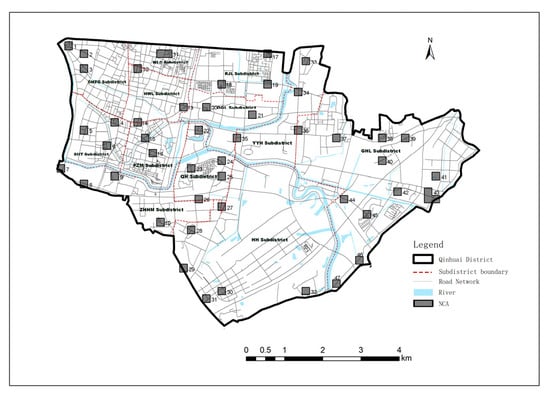
Figure 6.
Identified NCAs in Qinhuai District.
This study delineates DLCs by defining their boundaries based on the perpendicular bisectors of lines connecting neighboring NCA centers. The results reveal that DLC boundaries differ from subdistrict boundaries in Qinhuai District (Figure 7). The mean DLC area is 1.044 km2, with a median of 0.956 km2. Each NCA serves an average of 15,748 residents, with a median of 14,733. The mean number of elderly residents (60 years and older) served by each NCA is 2989, with a median of 2796 (Table 7).
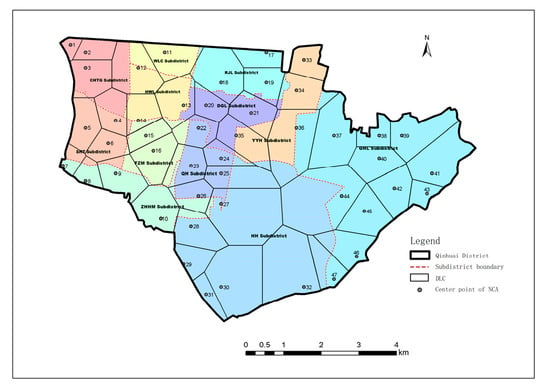
Figure 7.
DLC boundaries and subdistrict boundaries.
The area of DLC is not necessarily proportional to the population it serves (Table A1). The five largest DLCs are delineated based on NCA44, 27, 32, 30, and 36. These DLCs are distributed around an undeveloped area, previously the site of Nanjing Dajiaochang Airport (Figure 8). However, the five NCAs serving the largest number of residents are NCA12, 18, 11, 36, and 13 (Figure 9).
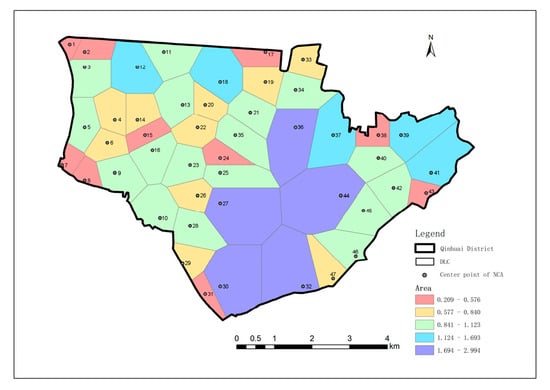
Figure 8.
Area served by NCAs.
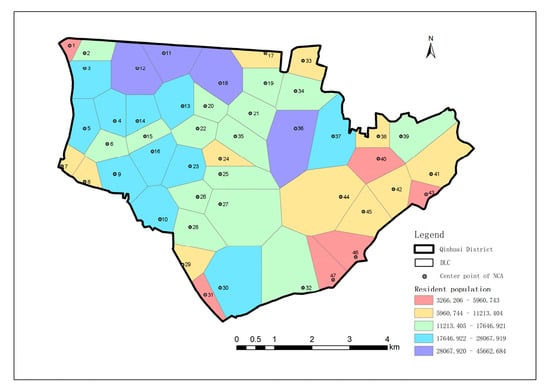
Figure 9.
Resident population served by NCAs.
3.2. Evaluation of the Identification Method
NCAs are not explicitly defined in urban planning documents; instead, they are based on residents’ perceptions and daily life habits. Consequently, a comprehensive sociological research approach is employed in this study to evaluate the NCA identification method, incorporating both field and questionnaire surveys. The field survey was conducted by a team of five researchers, who validated the accuracy of the identified NCAs by comparing the distribution of commercial and pedestrian facilities within the NCAs to that in other areas of the survey district. The questionnaire survey involved 40 participants (8 per subdistrict) who either reside, work, or both within the subdistrict. The questionnaire comprised four questions: three related to personal identity, presented as single-choice questions, and one regarding locations for accessing daily life services, measured using a five-level Likert scale. The field survey covered the entire study area. Due to the extensive scope of the study area, the questionnaire survey was conducted in the SHT, QH, GHL, RJL, and HH subdistricts, which are located in various directions of Qinhuai District (Figure 10).

Figure 10.
Questionnaire locations.
The field survey revealed that identified NCAs not only contain more commercial facilities than other areas within the subdistricts but also experience higher pedestrian traffic. The questionnaire results indicated that in the SHT, QH, GHL, RJL, and HH subdistricts, six, eight, six, seven, and eight respondents, respectively, “strongly agreed” that the NCA serves as the core area for accessing daily life services, such as purchasing food and repairing supplies. The remaining responses indicated “agreement”, with no participants expressing “disagreement” or “strong disagreement” (Figure 11). Notably, 82.5% of the survey participants had lived in the respective subdistricts for more than five years. Overall, the results of both evaluations reflect the reliability of the NCA identification method proposed in this study.
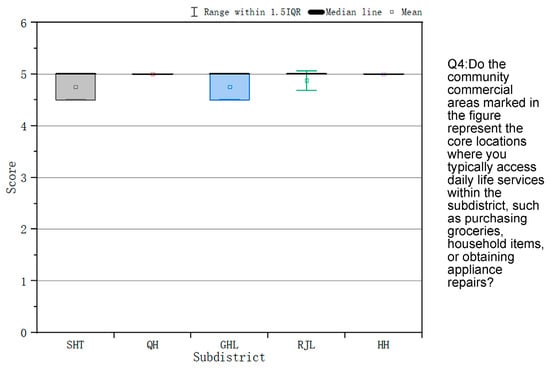
Figure 11.
Questionnaire results.
3.3. Formation of Neighborhood Commercial Areas
3.3.1. Establishment and Evaluation of the CatBoost Model
To ensure the model’s generalizability and prevent overfitting, we optimized the key parameters of the CatBoost model based on previous studies [16,46,67]. This study employed a grid search method combined with five-fold cross-validation to identify the optimal hyperparameters. Grid search is a parameter optimization technique that systematically explores combinations within specified parameter ranges to find the best configuration [71]. In each iteration, the training set was randomly divided into five subsets, with four subsets (70% of the data) utilized for model training and the remaining subset (30% of the data) reserved for testing. The parameter exploration range was defined as follows: the learning rate (controls the step size, affecting learning speed and overfitting) varied from 0.01 to 0.1, the maximum tree depth (determines model complexity) ranged from 2 to 8, the regularization lambda (prevents overfitting by penalizing large coefficients) from 1 to 9, and the number of iterations (the number of times the model is trained) was set at 200. The optimal model parameters identified were a learning rate of 0.1, a regularization lambda of 7, and a maximum tree depth of 8.
Given the minimal difference between the accuracy of the training set and that of the test set, overfitting was not observed. The evaluation results further demonstrated excellent performance of the model (Table 8).

Table 8.
Evaluation results of CatBoost model.
3.3.2. Interpretation of the Model
The importance of each variable influencing the formation of the NCA is as follows (Figure 12 and Figure 13): commercial diversity > public transport stop > parking > floor–area ratio > intersection > population density> closeness> housing price > road density> betweenness.
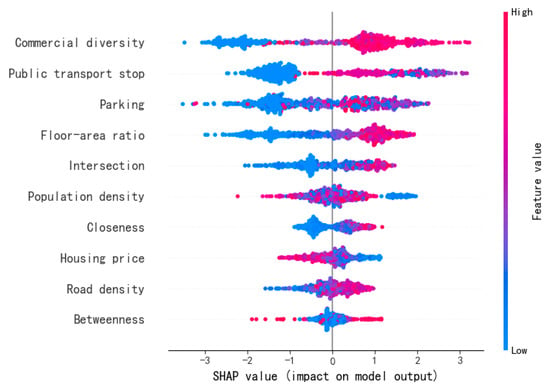
Figure 12.
SHAP summary plot.
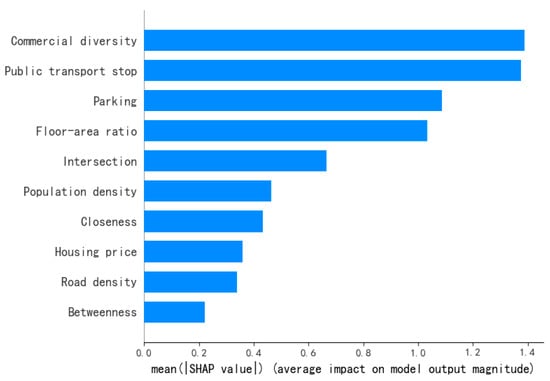
Figure 13.
SHAP standard bar chart.
The SHAP main effect plot shows the following findings (Figure 14): (1) Socio-demographic: The relationship between resident population and NCA formation follows an inverted “U” shape, though the local effect remains positive throughout. (2) Community attribute: The housing price shows an overall negative correlation with NCA formation, suggesting that higher prices may deter commercial agglomeration. Once housing prices exceed approximately 31,091.832 CNY/m2 (close to the mean price in Qinhuai District), the local effect on NCA formation shifts from positive to negative. (3) Land use: Both the floor–area ratio and commercial diversity exhibit an overall positive correlation with NCA formation. The floor–area ratio has a positive local effect when exceeding 0.600, while commercial diversity shows a positive local effect when the entropy index exceeds 0.251. (4) Road network: NCA formation exhibits an inverted “U” relationship with road density and a positive correlation with the intersection overall. The local effect of road density is positive in the range of 21.971–91.786 km/km2, and for the intersection, it remains positive above 38.467 counts/km2. (5) Street centrality: Street centrality makes a positive local contribution to NCA formation when betweenness surpasses 158.767 or closeness surpasses 0.000036. (6) Transportation facility: The local effect of transportation facility variables is positive when the density of public transport stops ranges from approximately 2.762 to 68.213 counts/km2 or when the density of parking is between 22.199 and 186.408 counts/km2.

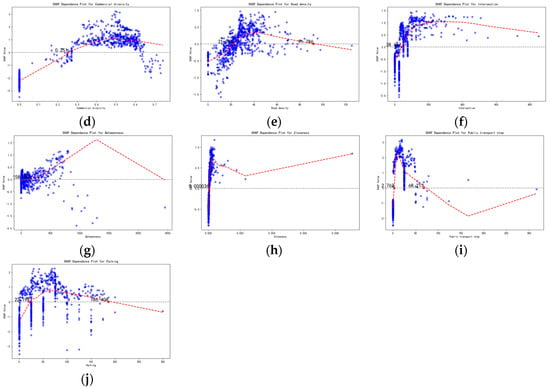
Figure 14.
Non-linear relationships between the formation of NCAs and the research variables: (a) the local effect of population density is consistently positive; (b) the overall negative impact of housing price on NCA formation; (c) the overall positive impact of floor–area ratio on NCA formation; (d) the overall positive impact of commercial diversity on NCA formation; (e) the local positive effect of road density exhibits a threshold; (f) the overall positive impact of intersection on NCA formation; (g) the overall positive impact of betweenness on NCA formation; (h) the overall positive impact of closeness on NCA formation; (i) the local positive effect of public transport stops exhibits a threshold; (j) the local positive effect of parking exhibits a threshold. (Note: x-axis represents the values of the variable indicated in the figure title, Y-axis represents SHAP values. A fitted curve (locally weighted scatterplot smoothing, LOWESS) is included to smooth scatter plots, with a steeper (flatter) curve indicating a higher (lower) marginal effect of the variable. Critical points and their values are where local effect changes are marked).
3.4. Types and Characteristics of Neighborhood Commercial Areas
Based on the differences in the spatial form indexes of commercial facilities, NCAs in Qinhuai District can be classified into three types: street type (ST), district type (DT), and district type (dominated by a complex) (DT-DC) (Figure 15a and Table 9). In ST NCAs, commercial facilities are aligned along one or both sides of a street, characterized by low COR and GCI (Figure 15b). DT NCAs consist of two or more streets with concentrated commercial facilities, providing broader spatial coverage of commercial activities. The spatial form is thus characterized by higher COR but lower DEN and GCI. Similar to ST NCAs, DT NCAs are predominantly composed of ground-floor shops in residential buildings (Figure 15c). DT-DC NCAs include ground-floor shops along the street, but the commercial facilities are primarily concentrated within a single complex. The complexes in the study area include wet markets and shopping malls. In contrast to the other two types, DT-DC NCAs are marked by low ELG and high GCI (Figure 15d).
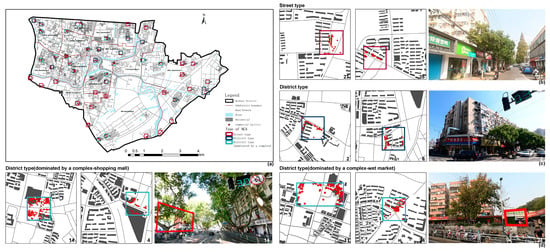
Figure 15.
Distribution and streetscapes of three types of NCAs: (a) distribution of NCAs and residential buildings; (b) ST; (c) DT; (d) DT-DC.

Table 9.
Three types of NCAs.
In Qinhuai District, ST NCAs are the most common, with 19 in total, primarily distributed along the ZHHM subdistrict. DT NCAs are fewer, with 10 instances mainly distributed in the DGL subdistrict. DT-DC NCAs, numbering 18, are concentrated in the WLC, HWL, and FZM subdistricts. Several subdistricts, including RJL, QH, YYH, and GHL, demonstrate a relatively high diversity of NCAs, encompassing all three types.
The results of the one-way ANOVA indicate that population density (p = 0.044), housing price (p = 0.012), and betweenness (p = 0.004) significantly influence the type of NCA. DT-DC NCAs are predominantly located in areas with higher population density (p = 0.044), housing price (p = 0.009), and betweenness (p = 0.014), showing significant differences compared to ST NCAs. Furthermore, a significant difference exists in betweenness (p = 0.021) between areas occupied by DT and DT-DC NCAs, with DT-DC NCAs situated in areas with relatively higher betweenness (Table 10 and Figure 16).

Table 10.
Factors influencing the types of NCAs.

Figure 16.
Characteristics of distribution areas for three types of NCAs: (a) population density; (b) housing price; (c) betweenness.
4. Discussion
This study proposes a method for identifying NCAs and illustrates its application with Qinhuai District in Nanjing as a case. The characteristics of NCAs support their suitability as central areas of DLCs, indicating that the method establishes a foundation for transcending administrative boundaries, facilitating precise, bottom-up allocation of community resources. Furthermore, the discussion on differences between factors influencing NCA formation and those affecting commercial facility distribution or commercial area vitality, along with analyzing the formation causes of various NCA types, provides reliable indicators for NCA planning.
4.1. Neighborhood Commercial Areas and Daily Life Circles
4.1.1. Differences from Urban Commercial Central Districts
In contrast to existing methods for identifying city-level commercial central districts [34], this study proposes a method for identifying neighborhood-level commercial areas. The method was applied to the Qinhuai District of Nanjing, where 47 NCAs were identified. Identified NCAs differ from urban commercial central districts in terms of functional composition, distribution characteristics, and service scale. Firstly, NCAs are primarily focused on providing daily life services, while urban commercial central districts mainly cater to higher-level consumption demands. Secondly, the Euclidean distance between nearest neighboring NCAs ranges from approximately 400 to 1000 m. Previous research shows that in the main urban area of Chinese cities, the Euclidean distance between adjacent urban commercial central districts spans 2000 to 7000 m [34,72]. This is because NCAs are situated within residents’ daily living ranges, while urban commercial central districts are situated within residents’ driving ranges. The distances between these two types of commercial agglomerations correspond to the acceptable walking and driving distances for residents. Additionally, the population served by NCAs ranges from 3266 to 45,663, whereas urban commercial central districts in China typically serve populations exceeding 100,000.
4.1.2. Delineation of Daily Life Circles
This study proposes a strategy for delineating DLCs centered on NCAs. The delineation results reveal a misalignment between the subdistrict boundaries of Qinhuai District and the DLC boundaries, which were delineated based on the actual distribution of residents’ daily activities and commercial facilities. This finding highlights the necessity of a bottom-up approach to delineating DLCs, as it enables the accurate allocation of services according to residents’ actual activity ranges. This approach helps prevent resource misallocation, enhancing both living convenience and the efficiency of economic operations. Notably, several identified NCAs are geographically proximate but serve small populations. For instance, the Euclidean distance between NCA1 and NCA2 is 447 m, with NCA1 serving only 4794 residents, including 910 individuals aged 60 and above. This population size is insufficient to maintain the consumption demand necessary for sustainable operations, especially for commercial facilities dependent on local consumer groups, such as nursing homes [73]. Therefore, future efforts to optimize DLCs should consider consolidating adjacent NCAs with limited served populations.
4.2. Method for Identifying Neighborhood Commercial Areas
This study proposes a method for identifying NCAs that integrates both the distribution of residents and commercial facilities. Compared to previous methods that rely solely on facility density [74], this method incorporates data on residents’ daily life activities, resulting in identification outcomes that more closely align with actual facility usage by residents. The resident activity data used are easily accessible, simple to process, and offer extensive spatial coverage [30]. In contrast to prior methods for identifying neighborhood centers [26,27,28], this method is more efficient and cost-effective, making it applicable over larger areas. The identification results demonstrate that the method effectively addresses disparities in commercial facility distribution, performing well in both low-density facility areas (eastern region) and high-density facility areas (western region) in Qinhuai District. Considering the functional composition, service radius, and scale of NCAs, designating NCAs as central areas of DLCs aligns with life circle planning objectives, as it ensures that residents can access essential services within walking distance. Moreover, the distinction between NCAs and urban commercial central districts demonstrates the necessity of developing specialized identification methods for NCAs. Importantly, the accuracy of this identification method has been validated through comprehensive sociological surveys.
4.3. Causes of Neighborhood Commercial Areas
4.3.1. Factors Influencing Formation
This study investigates the factors influencing the formation of NCAs in Qinhuai District, Nanjing. The results indicate that commercial diversity, public transportation stops, and parking facilities are the three most significant factors, while housing prices, road density, and betweenness are relatively less influential.
Certain findings of this study are consistent with previous research. It was observed that with increasing commercial diversity, floor–area ratio, intersection, betweenness, and closeness, the contribution of these variables to NCA formation shifts from negative to positive, while population density consistently shows a positive contribution. Previous studies have demonstrated that these factors promote the aggregation of commercial facilities [36,37,38] and enhance the vitality of commercial areas [42,43,44,45].
Some findings of this study differ from earlier research. Research employing linear analytical models has shown that transportation facility and road density promote commercial aggregation [37,39] and increase pedestrian traffic in aggregation areas [41,42]. However, the results from non-linear analytical models indicated that the positive impact of these two variables on NCA formation exists within a certain threshold range. Excessive density of transportation facilities and road networks also has a negative effect. This finding appears plausible, as transportation infrastructure and roads reduce the available space for commercial facilities, and the resulting traffic flow may pose safety risks, thereby restricting residents’ daily activities. This result provides more reliable indicators for NCA planning.
This study presents findings that are inconsistent with earlier research. Previous studies have suggested that areas with higher housing prices tend to have more amenities [75]. However, this study employs a similar modeling approach but finds a general negative impact of housing prices on NCA formation. This may be attributed to the fact that NCAs result from the combined selection of commercial facilities and resident activities. Housing prices generally reflect the economic status of residents. Higher-income groups tend to reside in low-density communities [76] and prefer diverse locations for daily activities [26,77]. This preference restricts the aggregation of daily life service facilities, which depend on a stable local customer base for operation. To address this issue, it is recommended that a portion of property fees in high housing price areas be allocated to reduce the rental of commercial facilities providing essential daily life services. This enhances the convenience of daily life for nearby residents.
4.3.2. Factors Influencing Types
NCAs in Qinhuai District, Nanjing, can be classified into three types, excluding the prevalent form of neighborhood commercial complex (NCC), where all daily life services are housed within a single building complex [78]. This community commercial model was introduced in China during the 2000s, while most residential communities in the study area were built in the 1990s. Additionally, Qinhuai is an old district of Nanjing, characterized by high land development density and fragmented plots, which constrain the availability of sufficient land for NCC construction. Therefore, some NCAs in Qinhuai District classified as DT-DC include commercial complexes that provide only a portion of daily life services within the area rather than the entirety.
This study reveals that types of NCAs are influenced by population density, housing prices, and betweenness. These three variables are significantly lower in ST NCAs compared to DT-DC NCAs. This discrepancy is attributed to the predominance of residential ground-floor shops in ST NCAs, where commercial activities largely rely on the daily consumption of local residents. In contrast, DT-DC NCAs aggregate a more diverse range of commercial facilities, whose operations necessitate greater commercial vitality and market demand. To some extent, resident density represents the potential consumer base, housing prices reflect the purchasing power of residents, and street betweenness measures potential traffic flow. Consequently, DT-DC NCAs are typically located in areas with higher residential population density, housing prices, and street centrality to sustain their operations. Notably, betweenness is the only variable significantly higher in DT-DC areas compared to the other two NCA types, underscoring its role as a determinant of NCA type. This finding aligns with previous studies, emphasizing the importance of street betweenness centrality in the distribution patterns of commercial activities [79].
5. Conclusions
This study presents a novel strategy to delineate DLCs centered on NCAs. A corresponding method for identifying NCAs is proposed. Furthermore, machine learning algorithms are employed to assess the importance of factors influencing NCA formation, particularly focusing on their non-linear and threshold effects. Finally, NCAs are classified, and the impact of area characteristics on NCA types is quantitatively analyzed.
The main contributions of this study are as follows: (1) This study provides a bottom-up strategy for regional planners to delineate DLCs, addressing the limitations of previous evaluative studies in guiding DLC planning at the overall level. This method is particularly significant for the development of DLCs in built environments in China, where in older cities, DLCs must be delineated based on existing conditions rather than being newly planned according to the life circle concept, as in newly developed districts. The proposed efficient and low-cost method for identifying NCAs establishes a foundation for delineating DLCs that align with residents’ daily life patterns. (2) By uncovering the non-linear and threshold effects of factors influencing NCA formation, this study provides reliable indicators for optimizing DLC center layouts. This contributes to meeting residents’ daily needs within walking distance, advancing the creation of livable urban environments and enhancing the well-being and social equity of various socioeconomic groups. (3) This study identifies key variables influencing NCA types, elucidating the area characteristics specific to each type. This provides a foundation for developing targeted planning strategies, thereby improving the efficiency of urban resource allocation. Furthermore, the findings will assist daily life service providers, such as restaurants and retailers, in making more informed decisions regarding the selection of service locations by considering factors such as population density and housing prices. This will promote the integration of commercial activities with neighborhood characteristics, supporting the sustainable development of neighborhood commerce.
This study presents several limitations. First, we utilized BHI to analyze community activity dynamics. Although these data offer valuable insights into residents’ activity patterns, their ability to capture the spatial locations of specific groups, such as children and older adults, is somewhat constrained due to the demographic of mobile device users. However, since these groups generally visit central areas less often, the impact of this limitation on the accuracy of the identification results may be minor. Future research could integrate BHI with travel survey data focused on specific populations, providing a more comprehensive view of activity patterns, particularly for children and the elderly. These data could also support analyses on how demographic factors, such as age and gender, influence residents’ utilization of and attitudes toward urban spatial functions. Second, this study focuses on socioeconomic and built environment factors when analyzing NCA formation, neglecting potentially influential cultural and historical aspects. Future research should incorporate relevant variables to achieve a more comprehensive understanding of the formation mechanisms of the central areas of DLCs. The analysis model of NCA formation developed in this study also requires further validation across diverse regions. Expanding the research scope to include other regions will contribute to the robustness and applicability of the model.
Author Contributions
Conceptualization, Tianyi Feng; methodology, Tianyi Feng; software, Tianyi Feng; validation, Tianyi Feng; formal analysis, Tianyi Feng; investigation, Tianyi Feng; resources, Tianyi Feng; data curation, Tianyi Feng; writing—original draft preparation, Tianyi Feng; writing—review and editing, Tianyi Feng; visualization, Tianyi Feng; supervision, Ying Zhou; project administration, Ying Zhou; funding acquisition, Ying Zhou. All authors have read and agreed to the published version of the manuscript.
Funding
This work was supported by the National Key R&D Program of China [grant number 2022YFF0607003] and the Ageing-Responsive Civilization Think Tank [grant number 24LLWM15].
Data Availability Statement
The data of this work can be shared with the readers depending on the request.
Conflicts of Interest
The authors declare no conflicts of interest.
Appendix A

Table A1.
Attributes of all NCAs.
Table A1.
Attributes of all NCAs.
| Subdistrict | Number of the NCA | Number of the Neighboring NCA | Euclidean Distance (m) | Area Served (km2) | Residents Served (People) |
|---|---|---|---|---|---|
| GHTG | 1 | 2 | 447 | 0.209 | 4794 |
| 2 | 3 | 400 | 0.538 | 13,989 | |
| 3 | 2 | 400 | 0.956 | 23,729 | |
| SHT | 4 | 14 | 600 | 0.840 | 22,885 |
| 5 | 6 | 721 | 0.892 | 21,259 | |
| 6 | 4 | 632 | 0.676 | 17,647 | |
| ZHHM | 7 | 8 | 721 | 0.333 | 6990 |
| 8 | 7 | 721 | 0.400 | 7461 | |
| 9 | 6 | 825 | 1.054 | 20,969 | |
| 10 | 28 | 825 | 1.123 | 22,970 | |
| WLC | 11 | 12 | 806 | 1.058 | 31,150 |
| HWL | 12 | 11 | 806 | 1.490 | 45,663 |
| 13 | 20 | 600 | 1.097 | 28,068 | |
| FZM | 14 | 15 | 447 | 0.749 | 22,031 |
| 15 | 16 | 447 | 0.528 | 13,329 | |
| 16 | 15 | 447 | 1.021 | 20,729 | |
| RJL | 17 | 19 | 800 | 0.559 | 10,995 |
| 18 | 20 | 721 | 1.504 | 33,829 | |
| 19 | 17 | 800 | 0.830 | 12,301 | |
| DGL | 20 | 18 | 721 | 0.604 | 13,626 |
| 21 | 32 | 721 | 0.967 | 16,709 | |
| QH | 22 | 20 | 632 | 0.770 | 15,873 |
| 23 | 24 | 825 | 0.929 | 19,833 | |
| 24 | 25 | 400 | 0.576 | 8880 | |
| 25 | 24 | 400 | 1.057 | 14,830 | |
| 26 | 27 | 632 | 0.713 | 14,733 | |
| 27 | 26 | 632 | 2.588 | 16,055 | |
| HH | 28 | 26 | 825 | 1.057 | 17,137 |
| 29 | 34 | 1000 | 0.619 | 11,108 | |
| 30 | 31 | 447 | 2.305 | 19,734 | |
| 31 | 30 | 447 | 0.405 | 5961 | |
| 32 | 47 | 825 | 2.315 | 13,686 | |
| YYH | 33 | 34 | 825 | 0.681 | 8903 |
| 34 | 33 | 825 | 1.095 | 17,203 | |
| 35 | 21 | 721 | 1.115 | 16,709 | |
| GHL | 36 | 34 | 1000 | 2.060 | 30,534 |
| 37 | 36 | 1020 | 1.693 | 23,555 | |
| 38 | 39 | 600 | 0.538 | 7652 | |
| 39 | 38 | 600 | 1.404 | 13,006 | |
| 40 | 38 | 600 | 0.956 | 4360 | |
| 41 | 43 | 550 | 1.561 | 9483 | |
| 42 | 43 | 877 | 0.993 | 11,213 | |
| 43 | 41 | 550 | 0.404 | 3266 | |
| 44 | 45 | 721 | 2.994 | 7927 | |
| 45 | 44 | 721 | 1.109 | 10,491 | |
| 46 | 47 | 850 | 0.961 | 3505 | |
| 47 | 46 | 850 | 0.745 | 3386 |
References
- Xu, Z.; Shang, Z.; Zhong, Y.; Han, L.; Li, M.; Yang, Y. Evaluating 15-min Walkable Life Circles for the Senior: A Case Study of Jiande, China. J. Asian Archit. Build. Eng. 2024, 1–17. [Google Scholar]
- Moreno, C.; Allam, Z.; Chabaud, D.; Gall, C.; Pratlong, F. Introducing the “15-min City”: Sustainability, Resilience and Place Identity in Future Post-Pandemic Cities. Smart Cities 2021, 4, 93–111. [Google Scholar] [CrossRef]
- Liu, T.; Chai, Y. Daily Life Circle Reconstruction: A Scheme for Sustainable Development in Urban China. Habitat Int. 2015, 50, 250–260. [Google Scholar] [CrossRef]
- Langdon, P. Portland Pursues the ‘20-min Neighborhood’. 2008. Available online: https://www.cnu.org/publicsquare/portland-pursues-%E2%80%9820-minute-neighborhood%E2%80%99 (accessed on 24 August 2024).
- Nanjing Municipal Bureau of Planning and Natural Resources. Nanjing Planning Guidance of 15-min Community Life Circle. 2023. Available online: http://ghj.nanjing.gov.cn/njsgtzyj/202306/t20230608_3931597.html (accessed on 22 August 2024).
- Department of Transport and Planning, Victoria State Government. 20-min Neighbourhoods. 2024. Available online: https://www.planning.vic.gov.au/guides-and-resources/strategies-and-initiatives/20-minute-neighbourhoods (accessed on 24 August 2024).
- Tong, M. 2023 Graduate Design Course|Research on the Ecology and Structure of Nanjing Fireworks Circle. 2023. Available online: https://arch.seu.edu.cn/2024/0124/c9122a479875/page.htm (accessed on 20 August 2024).
- Ministry of Housing and Urban-Rural Development of the People’s Republic of China. Standard for Urban Residential Area Planning and Design. 2018. Available online: https://www.mohurd.gov.cn/gongkai/zhengce/zhengcefilelib/201811/20181130_238590.html (accessed on 24 August 2024).
- Hu, S.; Song, W.; Li, C.; Lu, J. A Multi-Mode Gaussian-Based Two-Step Floating Catchment Area Method for Measuring Accessibility of Urban Parks. Cities 2020, 105, 102815. [Google Scholar] [CrossRef]
- Song, L.; Kong, X.; Cheng, P. Supply-Demand Matching Assessment of the Public Service Facilities in 15-min Community Life Circle Based on Residents’ Behaviors. Cities 2024, 144, 104637. [Google Scholar] [CrossRef]
- Jing, C.; Zhou, W.; Qian, Y.; Zheng, Z.; Wang, J.; Yu, W. Trajectory Big Data Reveals Spatial Disparity of Healthcare Accessibility at the Residential Neighborhood Scale. Cities 2023, 133, 104127. [Google Scholar] [CrossRef]
- Xie, H.; Wang, X.; Wang, Z.; Shi, Z.; Hu, X.; Lin, H.; Xie, X.; Liu, X. Mismatch between Infrastructure Supply and Demand within a 15-min Living Circle Evaluation in Fuzhou, China. Heliyon 2023, 9, e20130. [Google Scholar] [CrossRef]
- Smith, D.A.; Shen, Y.; Barros, J.; Zhong, C.; Batty, M.; Giannotti, M. A Compact City for the Wealthy? Employment Accessibility Inequalities between Occupational Classes in the London Metropolitan Region 2011. J. Transp. Geogr. 2020, 86, 102767. [Google Scholar]
- Gehl, J. Life Between Buildings: Using Public Space, 3rd ed.; Island Press: Washington, DC, USA, 2011. [Google Scholar]
- Cheng, L.; De Vos, J.; Shi, K.; Yang, M.; Chen, X.; Witlox, F. Do Residential Location Effects on Travel Behavior Differ between the Elderly and Younger Adults? Transp. Res. Part D Transp. Environ. 2019, 73, 367–380. [Google Scholar] [CrossRef]
- Zheng, J.; Hu, M.; Wang, C.; Wang, S.; Han, B.; Wang, H. Spatial Patterns of Residents’ Daily Activity Space and Its Influencing Factors Based on the CatBoost Model: A Case Study of Nanjing, China. Front. Archit. Res. 2022, 11, 1193–1204. [Google Scholar] [CrossRef]
- Duan, Z.; Zhao, H.; Li, Z. Non-Linear Effects of Built Environment and Socio-Demographics on Activity Space. J. Transp. Geogr. 2023, 111, 103671. [Google Scholar] [CrossRef]
- Rappaport, J. Consumption Amenities and City Population Density. Reg. Sci. Urban Econ. 2008, 38, 533–552. [Google Scholar] [CrossRef]
- Huang, Z.; Yin, G.; Peng, X.; Zhou, X.; Dong, Q. Quantifying the Environmental Characteristics Influencing the Attractiveness of Commercial Agglomerations with Big Geo-Data. Environ. Plan. B Urban Anal. City Sci. 2023, 50, 2470–2490. [Google Scholar] [CrossRef]
- Tan, D.; Nguyen, M.Q. Beyond the Palimpsest: Traditions and Modernity in Urban Villages of Shenzhen, China. Cities 2024, 151, 105093. [Google Scholar] [CrossRef]
- Mehta, V.; Mahato, B. Measuring the Robustness of Neighbourhood Business Districts. J. Urban Des. 2019, 24, 99–118. [Google Scholar] [CrossRef]
- Hernández, T.; Bennison, D. The Art and Science of Retail Location Decisions. Int. J. Retail Distrib. Manag. 2000, 28, 357–367. [Google Scholar] [CrossRef]
- Oppewal, H.; Holyoake, B. Bundling and Retail Agglomeration Effects on Shopping Behavior. J. Retail. Consum. Serv. 2004, 11, 61–74. [Google Scholar] [CrossRef]
- Hidalgo, C.A.; Castañer, E.; Sevtsuk, A. The Amenity Mix of Urban Neighborhoods. Habitat Int. 2020, 106, 102205. [Google Scholar] [CrossRef]
- Jones, M. For a “New New Regional Geography”: Plastic Regions and More-than-Relational Regionality. Geogr. Ann. Ser. B-Human Geogr. 2022, 104, 43–58. [Google Scholar] [CrossRef]
- Hasanzadeh, K.; Kyttä, M.; Lilius, J.; Ramezani, S.; Rinne, T. Centricity and Multi-Locality of Activity Spaces: The Varying Ways Young and Old Adults Use Neighborhoods and Extra-Neighborhood Spaces in Helsinki Metropolitan Area. Cities 2021, 110, 103062. [Google Scholar] [CrossRef]
- Hasanzadeh, K. Exploring Centricity of Activity Spaces: From Measurement to the Identification of Personal and Environmental Factors. Travel Behav. Soc. 2019, 14, 57–65. [Google Scholar] [CrossRef]
- Huang, H.; Zhou, D.; Wang, Y. An Analysis of the Spatial Organization of Community Life-cycle under Residential Morphological Categories. Urban Plan. 2021, 02, 94–101. [Google Scholar]
- Li, J.; Li, J.; Yuan, Y.; Li, G. Spatiotemporal Distribution Characteristics and Mechanism Analysis of Urban Population Density: A Case of Xi’an, Shaanxi, China. Cities 2019, 86, 62–70. [Google Scholar] [CrossRef]
- Song, Y.; Lyu, Y.; Qian, S.; Zhang, X.; Lin, H.; Wang, S. Identifying Urban Candidate Brownfield Sites Using Multi-Source Data: The Case of Changchun City, China. Land Use Policy 2022, 117, 106084. [Google Scholar] [CrossRef]
- Pavlis, M.; Dolega, L.; Singleton, A. A Modified DBSCAN Clustering Method to Estimate Retail Center Extent. Geogr. Anal. 2018, 50, 141–161. [Google Scholar] [CrossRef]
- Wei, J.; Sun, S. Commercial Activity Cluster Recognition with Modified DBSCAN Algorithm: A Case Study of Milan. In Proceedings of the 2019 IEEE International Smart Cities Conference (ISC2), Casablanca, Morocco, 14–17 October 2019; pp. 228–234. [Google Scholar]
- Li, J.; Long, Y.; Dang, A. Live-Work-Play Centers of Chinese Cities: Identification and Temporal Evolution with Emerging Data. Comput. Environ. Urban Syst. 2018, 71, 58–66. [Google Scholar] [CrossRef]
- Yang, J.; Zhu, J.; Sun, Y.; Zhao, J. Delimitating Urban Commercial Central Districts by Combining Kernel Density Estimation and Road Intersections: A Case Study in Nanjing City, China. ISPRS Int. J. Geo-Inf. 2019, 8, 93. [Google Scholar] [CrossRef]
- Han, Z.; Song, W. Identification and Geographic Distribution of Accommodation and Catering Centers. ISPRS Int. J. Geo-Inf. 2020, 9, 546. [Google Scholar] [CrossRef]
- Long, Y.; Huang, C.C. Does Block Size Matter? The Impact of Urban Design on Economic Vitality for Chinese Cities. Environ. Plan. B-Urban Anal. City Sci. 2019, 46, 406–422. [Google Scholar] [CrossRef]
- Sevtsuk, A. Location and Agglomeration: The Distribution of Retail and Food Businesses in Dense Urban Environments. J. Plan. Educ. Res. 2014, 34, 374–393. [Google Scholar] [CrossRef]
- Lin, G.; Chen, X.; Liang, Y. The Location of Retail Stores and Street Centrality in Guangzhou, China. Appl. Geogr. 2018, 100, 12–20. [Google Scholar] [CrossRef]
- Lu, C.; Yu, C.; Xin, Y.; Zhang, W. Spatial Distribution Characteristics and Influencing Factors on the Retail Industry in the Central Urban Area of Lanzhou City at the Scale of Daily Living Circles. ISPRS Int. J. Geo-Inf. 2023, 12, 344. [Google Scholar] [CrossRef]
- Larsson, J.P.; Öner, Ö. Location and Co-Location in Retail: A Probabilistic Approach Using Geo-Coded Data for Metropolitan Retail Markets. Ann. Reg. Sci. 2014, 52, 385–408. [Google Scholar] [CrossRef]
- Wu, H.; Chen, Y.; Jiao, J. Impact of Neighborhood Built Environments on Shopping Travel Modes in Shanghai, China. Transp. Res. Rec. 2019, 2673, 669–681. [Google Scholar] [CrossRef]
- Gunn, L.D.; Mavoa, S.; Boulangé, C.; Hooper, P.; Kavanagh, A.; Giles-Corti, B. Designing Healthy Communities: Creating Evidence on Metrics for Built Environment Features Associated with Walkable Neighbourhood Activity Centres. Int. J. Behav. Nutr. Phys. Act. 2017, 14, 164. [Google Scholar] [CrossRef] [PubMed]
- Hahm, Y.; Yoon, H.; Choi, Y. The Effect of Built Environments on the Walking and Shopping Behaviors of Pedestrians; A Study with GPS Experiment in Sinchon Retail District in Seoul, South Korea. Cities 2019, 89, 1–13. [Google Scholar] [CrossRef]
- De Gruyter, C.; Truong, L.T.; Zahraee, S.M.; Young, W. Street and Activity Centre Characteristics Associated with the Use of Different Transport Modes. Cities 2023, 141, 104468. [Google Scholar] [CrossRef]
- Bai, X.; Zhou, M.; Li, W. Analysis of the Influencing Factors of Vitality and Built Environment of Shopping Centers Based on Mobile-Phone Signaling Data. PLoS ONE 2024, 19, e0296261. [Google Scholar] [CrossRef]
- Liu, J.; Wang, B.; Xiao, L. Non-Linear Associations between Built Environment and Active Travel for Working and Shopping: An Extreme Gradient Boosting Approach. J. Transp. Geogr. 2021, 92, 103034. [Google Scholar] [CrossRef]
- CTR Mobile User Index Division CTR. China Search Engine Industry Research Report. 2023. Available online: https://www.itopmarketing.com/uploads/soft/20230613/1686633779.pdf (accessed on 24 August 2024).
- Yang, J.; Cao, J.; Zhou, Y. Elaborating Non-Linear Associations and Synergies of Subway Access and Land Uses with Urban Vitality in Shenzhen. Transp. Res. Part A Policy Pract. 2021, 144, 74–88. [Google Scholar] [CrossRef]
- Ye, Z.; Chen, Y.; Zhang, L. The Analysis of Space Use around Shanghai Metro Stations Using Dynamic Data from Mobile Applications. Transp. Res. Procedia 2017, 25, 3147–3160. [Google Scholar] [CrossRef]
- Fan, Z.; Duan, J.; Lu, Y.; Zou, W.; Lan, W. A Geographical Detector Study on Factors Influencing Urban Park Use in Nanjing, China. Urban For. Urban Green. 2021, 59, 126996. [Google Scholar] [CrossRef]
- Wu, C.; Ye, X.; Ren, F.; Du, Q. Check-in Behaviour and Spatio-Temporal Vibrancy: An Exploratory Analysis in Shenzhen, China. Cities 2018, 77, 104–116. [Google Scholar] [CrossRef]
- Hongbo, Z.; Difei, Y.; Changhong, M.; Guanghui, L.; Yuanbo, F.; Qianlong, B. The Location Distribution Characteristics and Influencing Factors of Cultural Facilities in Zhengzhou Based on POI Data. Sci. Geogr. Sin. 2018, 38, 1525–1534. [Google Scholar]
- Shen, Y.; Karimi, K. Urban Function Connectivity: Characterisation of Functional Urban Streets with Social Media Check-in Data. Cities 2016, 55, 9–21. [Google Scholar] [CrossRef]
- National Bureau of Statistics. Statistical Classification of Life—Related Service Industries. 2019. Available online: https://www.gov.cn/zhengce/zhengceku/2019-09/03/content_5426962.htm (accessed on 31 August 2024).
- Baidu Map POI Industry Classification. Available online: https://doc.bce.baidu.com/bce-documentation/DUMAP/tag.pdf (accessed on 31 August 2024).
- Nanjing Municipal Statistics Bureau. Nanjing Seventh National Population Census Bulletin. 2021. Available online: https://tjj.nanjing.gov.cn/bmfw/njsj/202105/t20210524_2945571.html (accessed on 31 August 2024).
- Anderson, T.K. Kernel Density Estimation and K-Means Clustering to Profile Road Accident Hotspots. Accid. Anal. Prev. 2009, 41, 359–364. [Google Scholar] [CrossRef]
- Lan, F.; Gong, X.; Da, H.; Wen, H. How Do Population Inflow and Social Infrastructure Affect Urban Vitality? Evidence from 35 Large- and Medium-Sized Cities in China. Cities 2020, 100, 102454. [Google Scholar] [CrossRef]
- Rui, J.; Li, X. Decoding Vibrant Neighborhoods: Disparities between Formal Neighborhoods and Urban Villages in Eye-Level Perceptions and Physical Environment. Sustain. Cities Soc. 2024, 101, 105122. [Google Scholar] [CrossRef]
- Tu, W.; Zhu, T.; Zhong, C.; Zhang, X.; Xu, Y.; Li, Q. Exploring Metro Vibrancy and Its Relationship with Built Environment: A Cross-City Comparison Using Multi-Source Urban Data. Geo-Spat. Inf. Sci. 2022, 25, 182–196. [Google Scholar] [CrossRef]
- Zhang, H.; Zhou, X.; Tang, G.; Zhou, L.; Ye, X. Hotspot discovery and its spatial pattern analysis for catering service in cities based on field model in GIS. Geogr. Res. 2020, 39, 354–369. [Google Scholar]
- Li, X.; Li, Y.; Jia, T.; Zhou, L.; Hijazi, I.H. The Six Dimensions of Built Environment on Urban Vitality: Fusion Evidence from Multi-Source Data. Cities 2022, 121, 103482. [Google Scholar] [CrossRef]
- Sevtsuk, A.; Mekonnen, M. Urban Network Analysis. A New Toolbox for ArcGIS. Rev. Int. Géomatique 2012, 287, 305. [Google Scholar] [CrossRef]
- Freeman, L.C. A Set of Measures of Centrality Based on Betweenness. Sociometry 1977, 40, 35–41. [Google Scholar] [CrossRef]
- Sabidussi, G. The Centrality Index of a Graph. Psychometrika 1966, 31, 581–603. [Google Scholar] [CrossRef]
- Hancock, J.T.; Khoshgoftaar, T.M. CatBoost for Big Data: An Interdisciplinary Review. J. Big Data 2020, 7, 94. [Google Scholar] [CrossRef]
- Huang, G.; Wu, L.; Ma, X.; Zhang, W.; Fan, J.; Yu, X.; Zeng, W.; Zhou, H. Evaluation of CatBoost Method for Prediction of Reference Evapotranspiration in Humid Regions. J. Hydrol. 2019, 574, 1029–1041. [Google Scholar] [CrossRef]
- Prokhorenkova, L.; Gusev, G.; Vorobev, A.; Dorogush, A.V.; Gulin, A. CatBoost: Unbiased boosting with categorical features. In Proceedings of the Neural Information Processing Systems (NeurIPS 2018), Montréal, QC, Canada, 3 December 2018. [Google Scholar]
- Lundberg, S.M.; Lee, S.-I. A Unified Approach to Interpreting Model Predictions. In Proceedings of the 31st Conference on Neural Information Processing Systems (NIPS 2017), Long Beach, CA, USA, 4 December 2017. [Google Scholar]
- Yu, B.; Shu, S.; Liu, H.; Song, W.; Wu, J.; Wang, L.; Chen, Z. Object-Based Spatial Cluster Analysis of Urban Landscape Pattern Using Nighttime Light Satellite Images: A Case Study of China. Int. J. Geogr. Inf. Sci. 2014, 28, 2328–2355. [Google Scholar] [CrossRef]
- Bergstra, J.; Bengio, Y. Random Search for Hyper-Parameter Optimization. J. Mach. Learn. Res. 2012, 13, 281–305. [Google Scholar]
- Hu, Q.; Bai, G.; Wang, S.; Ai, M. Extraction and Monitoring Approach of Dynamic Urban Commercial Area Using Check-in Data from Weibo. Sustain. Cities Soc. 2019, 45, 508–521. [Google Scholar] [CrossRef]
- Zwanziger, J.; Mukamel, D.B.; Indridason, I. Use of Resident-Origin Data to Define Nursing Home Market Boundaries. Inq. J. Health Care Organ. Provis. Financ. 2002, 39, 56–66. [Google Scholar] [CrossRef]
- Ruan, Y.; Liu, S.; Li, W.; Zhang, M. Spatial characteristics and influence factors of urban community center: Evidence from the Xihu District in Hangzhou City. Sci. Geogr. Sin. 2021, 41, 74–82. [Google Scholar]
- Taecharungroj, V. Google Maps Amenities and Condominium Prices: Investigating the Effects and Relationships Using Machine Learning. Habitat Int. 2021, 118, 102463. [Google Scholar] [CrossRef]
- Schuetz, J.; Kolko, J.; Meltzer, R. Are Poor Neighborhoods “Retail Deserts”? Reg. Sci. Urban Econ. 2012, 42, 269–285. [Google Scholar] [CrossRef]
- Fan, Y.; Khattak, A.J. Urban Form, Individual Spatial Footprints, and Travel Examination of Space-Use Behavior. Transp. Res. Rec. 2008, 2082, 98–106. [Google Scholar] [CrossRef]
- Yan, X.; Zhao, W. Variegated Urban Entrepreneurialism and Its Contested Results in the Boom of Neighborhood Center Complexes in Chengdu, China. Cities 2024, 150, 105039. [Google Scholar] [CrossRef]
- Porta, S.; Strano, E.; Iacoviello, V.; Messora, R.; Latora, V.; Cardillo, A.; Wang, F.; Scellato, S. Street Centrality and Densities of Retail and Services in Bologna, Italy. Environ. Plan. B Plan. Des. 2009, 36, 450–465. [Google Scholar] [CrossRef]
Disclaimer/Publisher’s Note: The statements, opinions and data contained in all publications are solely those of the individual author(s) and contributor(s) and not of MDPI and/or the editor(s). MDPI and/or the editor(s) disclaim responsibility for any injury to people or property resulting from any ideas, methods, instructions or products referred to in the content. |
© 2024 by the authors. Published by MDPI on behalf of the International Society for Photogrammetry and Remote Sensing. Licensee MDPI, Basel, Switzerland. This article is an open access article distributed under the terms and conditions of the Creative Commons Attribution (CC BY) license (https://creativecommons.org/licenses/by/4.0/).